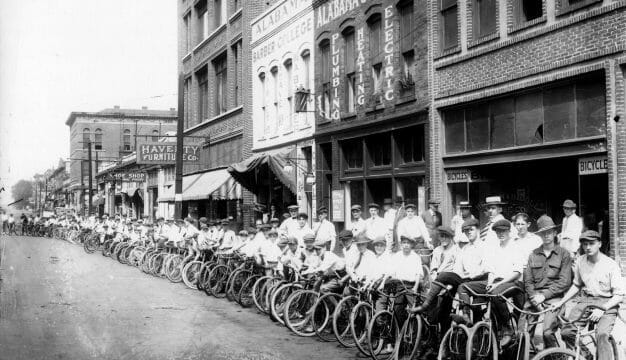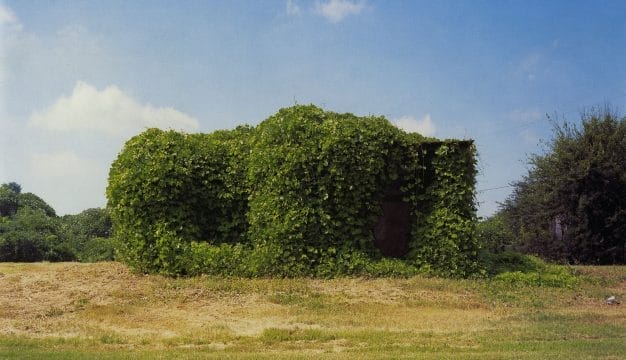Washington County
 Old Washington County Courthouse
Washington County is the oldest established county in the state of Alabama and originally included much of both the states of Alabama and Mississippi. It was the birthplace of Major League Baseball player and North Carolina congressman Wilmer David “Vinegar Bend” Mizell (1930-1999). The town of St. Stephens served as the capital of Alabama Territory. In 1807, former U.S. vice president Aaron Burr was arrested in Washington County for his attempt to raise his own army to invade Spanish territories in North America. The members of the country gospel group the Sullivan Family were from the unincorporated community of St. Stephens. Washington County is governed by an elected six-member commission.
Old Washington County Courthouse
Washington County is the oldest established county in the state of Alabama and originally included much of both the states of Alabama and Mississippi. It was the birthplace of Major League Baseball player and North Carolina congressman Wilmer David “Vinegar Bend” Mizell (1930-1999). The town of St. Stephens served as the capital of Alabama Territory. In 1807, former U.S. vice president Aaron Burr was arrested in Washington County for his attempt to raise his own army to invade Spanish territories in North America. The members of the country gospel group the Sullivan Family were from the unincorporated community of St. Stephens. Washington County is governed by an elected six-member commission.
- Founding Date: June 4, 1800
- Area: 1,081 square miles
- Population: 16,336 (2020 Census estimate)
- Major Waterways: Tombigbee River, Escatawpa River
- Major Highways: U.S. 45, U.S. 43
- County Seat: Chatom
- Largest Town: Chatom
History
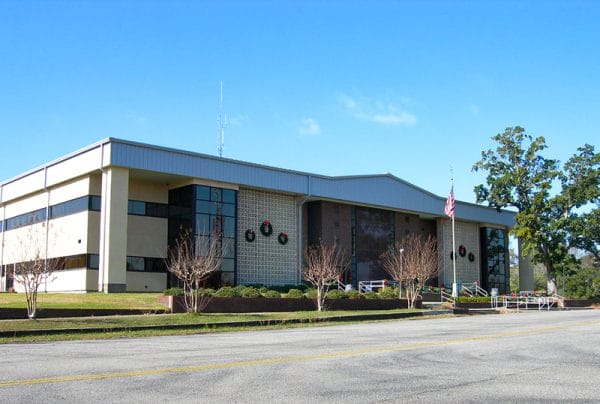 Washington County Courthouse
Washington County was created on June 4, 1800, as a county of the Mississippi Territory by proclamation of Gov. Winthrop Sargent. It was the first county in the state of Alabama, and the county’s original boundaries extended 300 miles east to west and 88 miles to the north and south. Some 26,400 square miles of Washington County’s original territory were carved out to make 16 counties in Mississippi and 29 counties in Alabama. Washington County was named after the first president of the United States, George Washington. The earliest settlers came to the county from Georgia and the Carolinas. Most early settlement took place on the west bank of the Tombigbee River. Some of the first towns included McIntosh, Wakefield, St. Stephens, and Chatom. The southern portion of Washington County is home to the MOWA (Mobile and Washington County) band of Choctaw Indians, whose ancestors settled in the area after the Creek War ended in 1814. Although the MOWAs have not received official recognition from the federal government, the group was formally recognized as a tribe of Alabama in 1979, making the MOWAs eligible for such services as education and housing.
Washington County Courthouse
Washington County was created on June 4, 1800, as a county of the Mississippi Territory by proclamation of Gov. Winthrop Sargent. It was the first county in the state of Alabama, and the county’s original boundaries extended 300 miles east to west and 88 miles to the north and south. Some 26,400 square miles of Washington County’s original territory were carved out to make 16 counties in Mississippi and 29 counties in Alabama. Washington County was named after the first president of the United States, George Washington. The earliest settlers came to the county from Georgia and the Carolinas. Most early settlement took place on the west bank of the Tombigbee River. Some of the first towns included McIntosh, Wakefield, St. Stephens, and Chatom. The southern portion of Washington County is home to the MOWA (Mobile and Washington County) band of Choctaw Indians, whose ancestors settled in the area after the Creek War ended in 1814. Although the MOWAs have not received official recognition from the federal government, the group was formally recognized as a tribe of Alabama in 1979, making the MOWAs eligible for such services as education and housing.
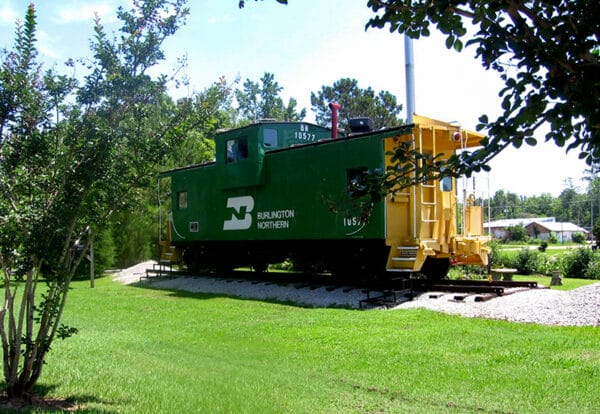 Caboose in Millry City Park
McIntosh served as the first county seat of Washington County. In 1804, the county seat moved from McIntosh to Wakefield. In 1811, the county seat moved to Rodney, which was eventually incorporated with Franklin into St. Stephens, which became the capital of Alabama Territory when it was established in 1817. Rodney remained the county seat until 1825, when it was moved near present-day Millry. In 1842, the more centrally located Barryton was chosen as the county seat. Five years later, however, Barryton became part of the newly created Choctaw County, so a new county seat was needed. In 1848, “New” St. Stephens was chosen as the county seat, and a two-story brick courthouse was built in 1852. When the county seat was again moved in 1907, the “New” St. Stephens courthouse was purchased by the town’s Masonic lodge and eventually given to the St. Stephens Historical Commission. Today, the restored courthouse serves as a town museum. The county seat moved in 1907 to Chatom, where a large brick courthouse was built. By 1960, the county had outgrown this courthouse. The original Chatom courthouse was torn down to make way for a larger, more modern one, which was dedicated on September 14, 1965 with Gov. George Wallace as a guest speaker. New additions were made to the courthouse in the 1990s.
Caboose in Millry City Park
McIntosh served as the first county seat of Washington County. In 1804, the county seat moved from McIntosh to Wakefield. In 1811, the county seat moved to Rodney, which was eventually incorporated with Franklin into St. Stephens, which became the capital of Alabama Territory when it was established in 1817. Rodney remained the county seat until 1825, when it was moved near present-day Millry. In 1842, the more centrally located Barryton was chosen as the county seat. Five years later, however, Barryton became part of the newly created Choctaw County, so a new county seat was needed. In 1848, “New” St. Stephens was chosen as the county seat, and a two-story brick courthouse was built in 1852. When the county seat was again moved in 1907, the “New” St. Stephens courthouse was purchased by the town’s Masonic lodge and eventually given to the St. Stephens Historical Commission. Today, the restored courthouse serves as a town museum. The county seat moved in 1907 to Chatom, where a large brick courthouse was built. By 1960, the county had outgrown this courthouse. The original Chatom courthouse was torn down to make way for a larger, more modern one, which was dedicated on September 14, 1965 with Gov. George Wallace as a guest speaker. New additions were made to the courthouse in the 1990s.
Major Cities and Demographics
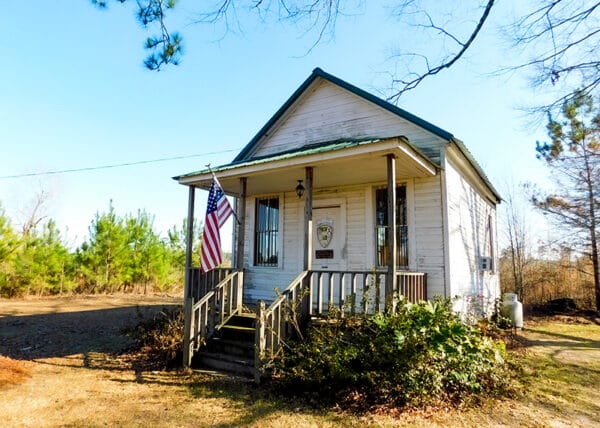 Old Post Office in Chatom
According to the 2020 U.S. Census, the population of Washington County was 16,336. Of that total, 66.0 percent of respondents identified themselves as white, 24.0 percent as African American, 7.5 percent as American Indian, 1.9 percent as two or more races, 0.2 percent as Asian, and 0.9 percent as Hispanic. The county seat, Chatom, is the largest town in Washington County with an estimated population of 975. Other significant towns are McIntosh and Millry. The median household income was $42,331, compared with $52,035 for the state as a whole, and the per capita income was $30,391, compared with $28,934 for the state as a whole.
Old Post Office in Chatom
According to the 2020 U.S. Census, the population of Washington County was 16,336. Of that total, 66.0 percent of respondents identified themselves as white, 24.0 percent as African American, 7.5 percent as American Indian, 1.9 percent as two or more races, 0.2 percent as Asian, and 0.9 percent as Hispanic. The county seat, Chatom, is the largest town in Washington County with an estimated population of 975. Other significant towns are McIntosh and Millry. The median household income was $42,331, compared with $52,035 for the state as a whole, and the per capita income was $30,391, compared with $28,934 for the state as a whole.
Economy
 Olin Plant
Washington County’s economy was based in agriculture until the early twentieth century. The early economy of the county centered on the local timberlands, with some large farms in the northern parts of the county. By the turn of the century, large sawmills were operating throughout the county. Turpentine collected from the pine forests became the “cash crop” of the county. In the early 1950s, large underground salt domes were discovered in the McIntosh area, leading to the establishment of salt mine operations and chemical production companies. Natural gas was discovered in the early 1970s in western Washington County, and Philips Petroleum built a refinery to take advantage of the newly discovered energy source. Olin Corporation has been producing chemicals at its facility in Washington County since 1952. Today, timber remains the main industry of Washington County.
Olin Plant
Washington County’s economy was based in agriculture until the early twentieth century. The early economy of the county centered on the local timberlands, with some large farms in the northern parts of the county. By the turn of the century, large sawmills were operating throughout the county. Turpentine collected from the pine forests became the “cash crop” of the county. In the early 1950s, large underground salt domes were discovered in the McIntosh area, leading to the establishment of salt mine operations and chemical production companies. Natural gas was discovered in the early 1970s in western Washington County, and Philips Petroleum built a refinery to take advantage of the newly discovered energy source. Olin Corporation has been producing chemicals at its facility in Washington County since 1952. Today, timber remains the main industry of Washington County.
Employment
According to 2020 Census estimates, the workforce in Washington County was divided among the following industrial categories:
- Manufacturing (21.5 percent)
- Educational services, and health care and social assistance (18.3 percent)
- Construction (12.9 percent)
- Professional, scientific, management, and administrative and waste management services (9.6 percent)
- Retail trade (8.8 percent)
- Transportation and warehousing, and utilities (7.4 percent)
- Arts, entertainment, recreation, and accommodation and food services (4.8 percent)
- Other services, except public administration (4.0 percent)
- Agriculture, forestry, fishing and hunting, and extractive (3.9 percent)
- Public administration (3.7 percent)
- Finance and insurance, and real estate, rental, and leasing (3.4 percent)
- Wholesale trade (1.6 percent)
- Information (0.1 percent)
Education
The Washington County School System oversees eight primary and secondary schools.
Geography
Comprising more than 1,000 square miles, Washington County is located in southwest Alabama. It is part of the Coastal Plain physiographic section. Washington County is largely rural, with extensive pine forests and shallow coastal soils. The county is bordered by Choctaw County to the north, Clarke County to the east, Mobile County to the south, and the state of Mississippi to the west.
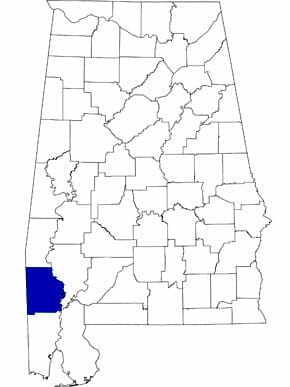 Washington County Map
The Tombigbee River and its tributaries run throughout Washington County. The river runs along the eastern border, with its lower tributaries flowing westward into Washington County. The Tombigbee River is considered one of the most critical rivers in terms of biodiversity in the southeast United States. The Escatawpa River begins in Washington County less than one mile from the Alabama-Mississippi border. The National Park Service describes the Escatawpa River as one of the finest undeveloped blackwater streams in the nation, although the watershed contains no public lands.
Washington County Map
The Tombigbee River and its tributaries run throughout Washington County. The river runs along the eastern border, with its lower tributaries flowing westward into Washington County. The Tombigbee River is considered one of the most critical rivers in terms of biodiversity in the southeast United States. The Escatawpa River begins in Washington County less than one mile from the Alabama-Mississippi border. The National Park Service describes the Escatawpa River as one of the finest undeveloped blackwater streams in the nation, although the watershed contains no public lands.
U.S. highways 45 and 43 are Washington County’s main transportation routes. U.S. Highway 45 cuts across the southwest corner of the county, and U.S. Highway 43 runs north-south along the eastern border of Washington County. Chatom Municipal Airport in Chatom is the county’s only airport.
Events and Places of Interest
 St. Stephens Historical Park
There are several recreational opportunities for visitors to Washington County. Once the territorial capitol of Alabama, St. Stephens Historical Park is a 200-acre reserve that includes a walking trail through the streets of the old town and a 90-acre quarry lake with white-sand beaches.
St. Stephens Historical Park
There are several recreational opportunities for visitors to Washington County. Once the territorial capitol of Alabama, St. Stephens Historical Park is a 200-acre reserve that includes a walking trail through the streets of the old town and a 90-acre quarry lake with white-sand beaches.
There are many places in Washington County to enjoy a variety of water sports and outdoor activities. Washington County State Lake is a spring-fed lake where visitors can fish and boat, and Chatom Lake boasts a community center where the public can hold meetings and reunions while taking advantage of the lake. There are a number of access points to the Tombigbee River in Washington County. Canoeing, kayaking, water-skiing, and jet-skiing are all popular activities available to the public.
Housed in the basement of the county courthouse in Chatom, the Washington County Museum preserves the history of the county and its residents. Various artifacts and historical papers are exhibited in the museum, offering visitors a glimpse into the past of Alabama’s first established county.
Further Reading
- The Heritage of Washington County, Alabama. Clanton, Ala.: Heritage Publishing Consultants, 2005.
- Matte, Jacqueline Anderson. The History of Washington County: First County in Alabama. Chatom, Ala.: Washington County Historical Society, 1982.
